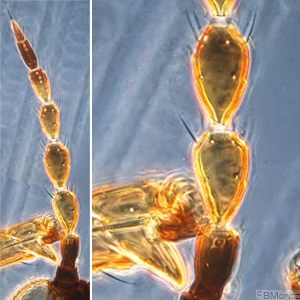Figures
Fig. 1: Antenna (inset: II.-IV. antennal segment)
Fig. 2: Head dorsal, with ocellar triangle, vertex and maxillary stylets
Fig. 3: Enlarged fore femur with basal tubercle/hump at inner margin
Fig. 4: Well developed prosternal plates (basantra, ferna, prospinasternum)
Fig. 5: Meso- and metanotal sclerits, triangular pelta
Fig. 6: Forewing, weakly constricted medially, duplicate cilia present
Fig. 7: Tergites IV and V with two pairs of sigmoid wing retaining setae
Fig. 8: Tergites IX and X of abdomen, tube shorter than head
ITS-RFLP gel patterns (1&8 ladder, 2 PCR-product, 3 RSAI, 4 HaeIII, 5 MspI, 6 HinfI, 7 AluI)
Fig. 9: Primer pair TODA1/TODA2
Taxonomic Information
Species:
Androthrips ramachandrai Karny, 1926
Common name:
None established
Present taxonomic position:
Family: Phlaeothripidae Uzel, 1895
Subfamily: Phlaeothripinae (Uzel) Priesner, 1928
Genus: Androthrips Karny, 1911
Species Recognition
General information about the genus Androthrips:Most of the species in this genus are thought to be predators of other thrips. We know that A. flavipes consumes the eggs and larvae of Arrhenothrips ramakrishnae within galls of this species. However, little is known about the biology of the remaining species within the genus and most are associated with Ficus plants.
Typical character states of Androthrips ramachandrai:
Body color
Mainly brown
Antennae
Number of antennal segments: 8
Segment III - number of sense cones: 2-3
Segment IV - number of sense cones: 3
Segments III & IV sensoria: emergent and simple
Head:
Basal thirds of cheeks: without a pair of stout setae
Maxillary stylet position: about one third of head width apart
Postocular setae: about half to nine tenths as long as eye
Postocular setal apex: capitate to broadly expanded
Maxillary bridge: present
Cheeks: without one pair of stout setae in basal third
Prothorax
Number of pairs of elongate pronotal setae: 2-3
Pronotum: with faint sculpture
Prosternal basantra: present
Metathorax
Metanotum structure: with irregular equiangular regulations medially
Wings
Forewing shape: parallel sided
Forewings: surface smooth, without veins, setae and microtrichia
Legs
Fore femur: with a strong, cylindrical tooth near the base followed by a row of small tubercles
Abdomen:
Abdominal segment X: complete tube in both sexes
Abdominal tergites: with curved wing-retaining setae
Biology
Life history:
Unknown, but is thought to be similar to A. favipes in that adults enter the galls produced by other thrips species and feed on the gall inducing thrips species: Gynaikothrips uzeli (Zimmermann) and G. ficorum (Marchal) (Thysanoptera: Phlaeothripidae) (Takahashi 1934).
Host plants:
Ficus (Moraceae)
Vector capacity:
None identified
Current known distribution:
India, Costa Rica, Taiwan, Thialand, Australia, North America
Additional notes:
Androthrips ramachandrai is thought to be introduced through shipments of nursery-grown Ficus in the U.S.
Bibliography
Akahashi, R (1934): Association of different species of thrips in their galls (in Japanese). Botany Zool., Tokyo 2: 1827-1836.
Boyd, DW Jr & Held, DW (2006): Androthrips
ramachandrai (Thysanoptera:
Phlaeothripidae): an introduced thrips in the United States. Florida
Entomologist, 89(4), 455-458.
Cott, E. H. (1956): Systematics of the suborder Tubulifera
(Thysanoptera) in California. University of California Publications in
Entomology, Vol. 13, ppg. 1-216.
Links:
Mound, LA (2005): Thysanoptera (Thrips) of the World
- A Checklist. http://www.ento.csiro.au/thysanoptera/worldthrips.html










